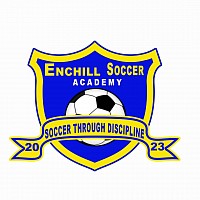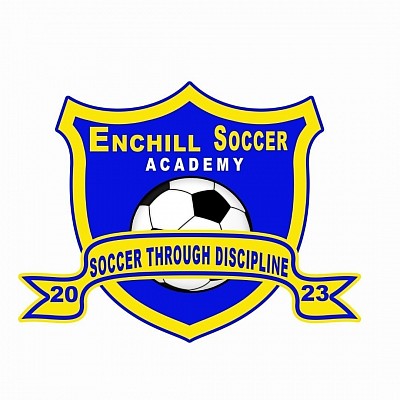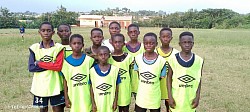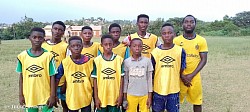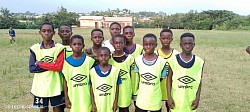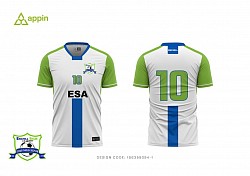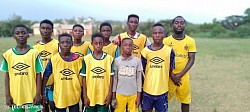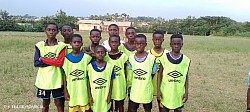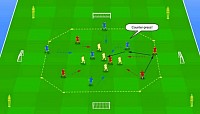ENCHILL SOCCER ACADEMY
SOCCER THROUGH DISCIPLINE
ENCHILL SOCCER ACADEMY
RULES, REGULATIONS AND CODES OF CONDUCT
General Rules
1. Any girl or boy aged between 4 to 14 years old can be a player in the “Enchill” Soccer Academy (ESA).
2. Maximum number of players for one coach, during the training sessions depends on the age group age of players. The numbers cannot exceed 18 for players between 11-14 years old, 16 for players age 7-10 and 10 for players age 4-6.
3. Every player must complete an Academy Medical Consent and Membership & Declaration forms, before starting any activities.
4. Every player is required to abide by the rules and regulations of (ESA).
5. Every player must behave in a friendly manner and create a positive atmosphere. Any problems have to be reported to the Coach, personally or front of the team.
6. Players of ESA are not allowed to: smoke, drink alcohol or use any drugs.
7. Absence of players without any information or authorization from the Coach is unacceptable. Any such unauthorized absences will be investigated to find out the reason.
8. Players selected to represent ESA in games, are required to attend and be available to play.
9. Under the new Football Association regulations, any coach, assistant or manager, will be required to have undergone a CRB check, to enable them to carry on or take up that role.
§ 2
Parents, Guardians & Supporters Code of Conduct
1. During the training sessions and games, parents, guardians and supporters should avoid contact with the player to allow them to fully concentrate.
2. During the training sessions and games, parents, guardians and supporters should stay on stand and never enter the field.
3. Parents, guardians and supporters should always show respect to match officials, the coaches and assistant, and also applaud the opposition as well as their own team.
4. Parents or guardians should always pay fees promptly as requested.
5. Enchill Soccer Academy will not refund any money for a small period of absence by a player. In case of sickness or long-term injury parents or guardians should contact the coach to give information about likely absence time. If the absence is expected to be longer than 3 weeks, the amount of fee will have to be discuss with the coach.
6. Parents or guardians should always inform the coach of the team about any absence of the player.
7. In case of resignation from ESA, parents or guardians must let ESA know either by letter, phone call or email massage.
8. Parents or guardians should respect the coache’s decision at all times and give the coach and players their full support. In case of any problems they should talk to the coach of ESA.
9. All ESA activities are out of school hours. Parents or guardians are responsible for transporting players to and from the trainings and matches.
§ 3
Players Code of Conduct
1. Every single player of ESA should have medical clearance and parents or guardians approvement to take part of training sessions and matches.
2. As a player of Enchill Soccer Academy you should:
a) Set and maintain a high level of good conduct and behaviour, both on and off the field of play.
b) Always wear shin pads protection,
c) Before, during and after training always help the coaches with training equipment,
d) Pay attention to the coach and never talk whilst they are giving instructions
e) Be prepared to learn and to concentrate fully during training,
f) Report any injuries immediately to the coach,
g) Not contact parents, guardians or supporters during the training sessions and matches
h) In your free time practice technique and tricks learned during the training sessions,
i) football equipment which players use, is owned by ESA and must be treated with respect. After the matches or training sessions, the equipment must to be handed back to the coach, except for any equipment which parents or guardians have paid for.
3. The purpose of selecting the players to play in matches or tournaments is regular and punctual attendance and commitment on training sessions.
4. Players who fail to attend training session at least twice a week, without reasonable reason, cannot be considered for selection for ESA teams for games or tournaments.
§ 4
Coaches Code of Conduct
1. Always have a contact number with you at a match or training event for all your players.
2. Stay in attendance at a match or training event, until the last player has safely left for home.
3. Inform all players and their parents or guardians, of their selection or nonelection for a match.
4. Inform players and their parents or guardians of the address where a match or training event is taking place and at what time it starts and finishes
5. Ensure the well-being and safety of every player above all other considerations.
6. Respect the rights, dignity, worth and opinions of all players as well as officials, parents or guardians and the opposition.
7. Encourage and guide players to accept responsibility for their own behaviour and performance.
8. Ensure that the activities you direct or advocate are appropriate for the age, maturity, experience and ability of the players.
9. Always display high standards of behaviour and be a positive role model for players, parents or guardians and spectators alike.
10. Help the players to recognize good performance and not just good results.
11. Co-operate fully with other people/specialists in the best interests of the player (e.g. Club officials, other coaches, doctors, physiotherapists etc).
12. Advise the Board of Enchill Soccer Academy if any approach is made to you by another club who wish to offer one of your players a trial or transfer.
13. Never use inappropriate, foul or abusive language or tolerate such language from players, parents or guardians or spectators.
14. Never discriminate against any player, parent or guardian or spectator (including from opposition teams) by reason of gender, sexual orientation, racial origin, nationality, religious beliefs, ability, disability or economic status.
15. Never show unacceptable favoritism to any individual player.
16. Do not punish or belittle a player for losing a match or making mistakes.
17. Never smoke, drink or use banned substances whilst actively working with players.
§ 5
Internal Awards
1. Internal player’s award in Enchill Soccer Academy are:
a). praise,
b). congratulation letter,
c). certificate of excellence,
d). gift awards,
2. Only Board of Enchill Soccer Academy can decide who will receive an award.
§ 6
Internal Discipline Procedures
1. ESA will run its own internal disciplinary procedures as follows:
a). reminder,
b). reprimand,
c). suspension from 1 to 5 training sessions,
d). disqualification for up to 6 months.
2. In case of poor school results, ESA, parents or guardians can make a decision to temporarily withdraw the player from training sessions, until such time as the player meets the school targets.
§ 7
Fees of Enchill Soccer Academy
1. To become a playing member of the Enchill Soccer Academy, the following fees have to be paid:
a) registration form - GH₵50.00
2. Training equipment for GH₵250.00, including:
a) football training t-shirt and short,
b) football training socks,
c) football training track suit / cardigan,
d) football training bag,
§ 8
Final Rules and Regulation’s
1. Enchill Soccer Academy Board can amend rules, regulations and code of conduct at any stage, after parents or guardians have been informed.
2. Not following the points of ESA rules, regulations and code of conducts may lead to dismissal from the Enchill Soccer Academy.
3. Once every 6 months coaches have to organize a meeting with parents or guardians to discuss player achievement and to set goals.
4. All other cases not included in these rules, regulations and codes of conduct are the responsibility of the ESA board who has the delegated right to make decisions.
Board of Enchill Soccer Academy
PHYSICAL CHARACTERISTICS
1. Sound Fundamentals
Teams that have sound soccer fundamentals will perform at a higher level each and every minute of game time. Good skill sets surrounding trapping, dribbling, passing, shooting, and heading allow soccer players to perform higher with every touch of the ball.
This translates to higher possession, more ball control, and better shooting. These characteristics sharply increase the chances of your team winning.
2. Fully Fit and In Shape
Soccer is truly a game of endurance, and a fully fit team stands a much better chance of performing well. Keeping a team in shape and fully fit requires constant training that is specifically focused on fitness, with running and agility exercises daily or weekly.
Teams that emphasis fitness, though, tend to do better. More goals are scored at the end of a game than at the beginning, and this has a lot to do with one team getting tired and the other capitalizing.
3. Always Improving
Good soccer teams are always improving their fitness and fundamentals, even throughout the season. So often, teams focus on fundamentals and improvement in training sessions before the season starts, but slack off as the season gets going.
Good teams are always working hard to improve, even if the changes are incremental and small. You can see this play out as the successful teams pull away in the end.
Tactical Characteristics
4. Proper Positioning
For a lot of teams that don’t end up succeeding, they can be considered to be a collection of good individual players, but not a team. While there are a lot of factors that go into playing as a team, one of the most important is proper positioning.
A good soccer team utilizes all 11 players on the field in the best manner possible, with each player understanding their position on the field. Proper positioning allows the coach to fully implement their strategy, and each player to maximize their abilities.
5. Good Communication
Soccer is a fast paced game with a lot of movement, and players will constantly be defending and counter-attacking. This frequent movement across and around the pitch means that communication is paramount.
Good communication allows teams to capitalize on mismatches in the game, while simultaneously not exposing themselves to danger.
6. Cover for Each Other
Covering for each other is really a combination of the first two points, but brings the tactical essentials together. Through proper positioning and good communication, soccer teams can outpace, outplay, and beat other teams. All of this culminates in the simple concept of covering for each other, whether on offense or defense.
Mental Characteristics
7. Steadfast Belief
Soccer games can swing on a single goal, and it is easy to get down on yourself (and the team) when something doesn’t go your way. Belief in the strategies and tactics that have been set up, along with the belief in fellow teammates, is essential.
So often, the most successful of teams remain steadfast in their belief that they can win the game. These teams are able to “dig deep” to find what is necessary to win games.
8. Mental Fortitude
Mental fortitude in soccer plays itself out in the ability to execute the game plan and soccer tactics, even when it is very difficult. Whether the team needs to absorb a lot of opposing pressure, or rebound from missing several wide open shots, a team needs to have the mental fortitude to push forward.
Many have correctly identified this as having a short term memory. The best forwards forget their misses, continuously shooting. The best defenders forget their penalties, continuing to make timely tackles.
9. Constant Focus
Successful teams rarely have mental lapses, and this can be accounted to their constant focus. While a soccer game is more than 90 minutes long, it only takes a few seconds for the game the swing. Often, this is the result of a lapse in concentration and focus.
Staying focused for 90+ minutes is difficult, and the successful teams are able to do this down each and every player.
Bring these 9 characteristics to your soccer team, and continuously working on them to see improvement and success!
SOCCER PRACTICE SCHEDULE
WARM UP
To reduce the risk of injuries and to increase your heart rate, warm up before beginning your soccer drills. Start your own warm up with a light 15 to 20 minutes jog around the field. Jugging also increase your cardiovascular endurance. After jogging spend about 10 minutes on stretches. Stretching increase your range of motion and improves your ability. Slugger you shush your entire body but focus primarily on static leg stretches. Toe touching and the standing quadriceps stretch which is performed by grabbing your ankle and bringing your heel toward your buttocks, minimized the potential for injury on the soccer field.
SPRINTS
A soccer game consists of sudden burst of energy for this type of activity use your practice time to improve your aerobic endurance. You can accomplish this by performing sprint across the field. Tried to sprint across the field to 24 minutes and also two to four times. Give yourself a 30 seconds rest in between sprints. Racing other players may motivate you to own faster across the field.
BALL HANDLING AND CONTROLLING
Ball-handling is a core skills for soccer player who must learn to control the ball with only their feet as only goalies who May touch the ball with their hands. Set up 5 to 10 coins in the straight line of the field. Position the cons about 3 ft apart. Practice dribbling by weaving through the cones while controlling the ball. Use both the inner and outer edge of each foot to move the ball. When you become proficient at dribbling through the cones replace the cones with teammates. While these teammates give you mild resistance try to grip the ball around them.
PASSING
Adopt passing moves the ball across the field so that your team can score. Practice passing the ball backwards and forwards with teammates for about 5 minutes. Focus on developing the skills to quickly stop the ball and returned it. Also practice dribbling the ball across the field and passing it backwards and forwards with your teammates. Remember to kick the ball slightly out in front of your teammates as you are both running so you're passing to a moving targets practice this passing drill for about 10 minutes. Gradually increase your speed in moving the ball across the field with your teammates.
SHOOTING
Shooting score goals which enable your team to win the match. Place the bow in the various locations around the front of the goal. Try to kick the ball past the goalie from both close and long-range. Try 10 shots on goal. This part of practice also provides a good workout for you and your goalie as well as he tries to block the incoming shorts. After kicking the ball from a stationary position dribble towards the goal and shoot 10 more times. Dribble and shoot at the go from various angle to the dynamic approach you will experience in a game.
INTER-SQUAD SCRIMMAGE
End your practice session with 40 to 60 minutes inter-squad screaming to put into play their skills you've practiced. Strive to work on all of your skill in the scrimmage.
The scrimmage give you a good opportunity to work on both offensive and defensive skills. This part of practice also help you to develop your peripheral vision so that you can better see all the players on the field.
SOCCER PRACTICE SCHEDULE
#Training Football
Three Colours - Counter-pressing Drill ⚔️
🔹 Drill Explanation
In this game, the Blue team and the Red team begin with the ball and work together to pass it around as much as they can. The goal of the game is for the Yellow team to take the ball away from them. When the Yellow team successfully gets the ball, they work together to score in one of the four mini-goals.
When either the Blue or Red team loses the ball, both teams immediately try to win it back by pressing the opponent who has the ball.
In the next wave, the Yellow team partners with the Blue team to try and score, while the Red team focuses on pressing and trying to regain possession.
NEW WAVE
1. Pressers (Team Trying to Win the Ball Back) -> In Possession:
- The team actively pressing and trying to regain possession is now in control of the ball.
2. Team that Lost Possession -> Pressers:
- The team that lost possession becomes the pressing team in an attempt to win the ball back.
3. Team that Didn't Lose Possession -> In Possession:
- The team that successfully retained possession continues to be in control of the ball.
🔹 Scoring System
WHEN you regain possession within 5s after losing the ball, your team gets one point.
WHEN you score on one of the mini-goals after regaining possession, your team gets one point.
WHEN you play the ball around 10 times, your team gets one point.
🔹 Progressions
1st block (8'): drill explanation - focus on counter-pressing. Both teams counter-press when one of the two teams loses possession. This means it's only after a goal attempt that we start a new wave with new roles.
2nd block (8'): progression - only the 'LOSERS' will counter-press, while the other two combine to score on one of the four mini-goals.
3rd block (8'): add depth in your coaching - where to press, when to press, how to press!
